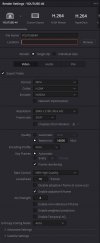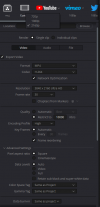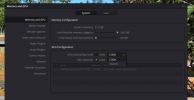I wanted to show off my flowers, so I flew with the drone to the side to gradually show the whole flower bed. The result was not nice. The image is torn and the vertical lines have moiré. (You can see the link.) A slower motion would help, but ... it's normal. Can any specific settings be used?

You are using an out of date browser. It may not display this or other websites correctly.
You should upgrade or use an alternative browser.
You should upgrade or use an alternative browser.
Jerky/Shaky video
- Thread starter Jirka
- Start date
herein2021
Well-Known Member
I wanted to show off my flowers, so I flew with the drone to the side to gradually show the whole flower bed. The result was not nice. The image is torn and the vertical lines have moiré. (You can see the link.) A slower motion would help, but ... it's normal. Can any specific settings be used?

Your bitrate is crazy high, the video will be badly compressed by any online platform, and will have problems playing back on most desktops/laptops even after downloading it. I checked my high end video editing GPU while playing it back and even it was around 54% used. For your export settings at 4K you really don't need anything higher than about 16Mb/s. The bitrate of the video you linked was 141Mb/s, by comparison even DVDs only have a bitrate of about 11Mb/s.
I don't know what video editor you are using, but you will definitely want to go into the export settings and lower the bitrate to around 16Mb/s for 4K video. If you are not using a video editor at all, and the video was straight out of the camera, then you will need something like Handbrake to lower the bitrate before it is useable.
Video straight out of cameras like drones is not useable until it has been edited in some way, even if it is just to lower the bitrate.
Oh and the rose bushes looked awesome by the way
Last edited:
Thank you for the explanation and for the award / praise! I thought the bigger the bitrate the better the quality. Do you understand why drone manufacturers deploy / construct such a high bitrate? After all, it places greater demands on energy consumption and there is always little / lack of drone.
I use the application Photos from Win11 for normal shortening / cutting of the video. As an attempt, I rendered the entire video in DaVinci app and set the bitrate to 16 Mbps. I'm attaching the video, but the result is very bad. But I'm not very familiar with the program, so I don't know if I did something wrong.

I use the application Photos from Win11 for normal shortening / cutting of the video. As an attempt, I rendered the entire video in DaVinci app and set the bitrate to 16 Mbps. I'm attaching the video, but the result is very bad. But I'm not very familiar with the program, so I don't know if I did something wrong.
herein2021
Well-Known Member
Thank you for the explanation and for the award / praise! I thought the bigger the bitrate the better the quality. Do you understand why drone manufacturers deploy / construct such a high bitrate? After all, it places greater demands on energy consumption and there is always little / lack of drone.
I use the application Photos from Win11 for normal shortening / cutting of the video. As an attempt, I rendered the entire video in DaVinci app and set the bitrate to 16 Mbps. I'm attaching the video, but the result is very bad. But I'm not very familiar with the program, so I don't know if I did something wrong.

Most cameras use high bitrates during the capture phase, you want a high bitrate to ensure no matter what the scene is, it gets captured accurately and without artifacts. I have cameras that go as high as 2.6Gb/s during the capture phase. From there you can edit the footage and lower the bitrate to something more reasonable; if the footage starts showing artifacts then you can raise the bitrate.
Video bitrates are similar to photography bit depth. A typical DSLR or mirrorless camera captures raw images with either 14bits or 16bits of data. This gives you editing longitude to enhance and finish processing the image without it falling apart. But when you deliver to your customer you typically deliver in 8bit JPGs or for higher end commercial customers you can deliver in 16 bit TIFF.
Something is definitely off with the video you sent this time. Not sure what it is, below is a screenshot of my YouTube export settings, maybe you can compare and see if there is anything different with yours. Also, did you use the "Native" encoder or a HW encoder? If your encoder is set to "Native" in DR you will probably experience problems, you always want to use the hardware encoder option. In the screenshot below, my encoder is set to NVIDIA.

herein2021
Well-Known Member
Bingo ! Thanks to you, I won. I had to uncheck the GPU selection option. I don't know yet what to choose in case of GPU processing mode.
View attachment 14424
I would leave that at Auto, under Decode Options ensure it looks like the below screenshot. Also, in your screenshot a lot of other settings are different from mine, such as VBR is not an option, your framerate is 30FPS vs 29.97FPS, and your encoding profile is set to High instead of Auto. The difference could be because mine is a paid version, but as long as your footage is 8bit then the free version should work fine.

Last edited:
imtense images
Member
- Joined
- May 29, 2022
- Messages
- 11
- Reaction score
- 3
- Age
- 44
herein2021
Well-Known Member
I always thought the higher the bitrate the better
Definitely not, if you exceed the destination platform's recommended bitrates they recompress the footage with their own compression which typically introduces artifacts and other unwanted problems into the footage. To be entirely technically accurate...they recompress the source footage regardless of the bitrate, but when the bitrate is too high you are more likely to get artifacts, uploads take longer, processing takes longer, storage space requirements on your computer increase exponentially, etc. Here is Google's official bitrate recommendations for YouTube. IMO even those are on the high side. I use 16Mb/s for 4K footage since I don't shoot sports or fast action.
For a talking head interview type video, you can easily go as low as 8Mb/s or even 4Mb/s with 4K footage and it will not be noticeable. The higher bitrates are really needed based on the number of pixels that change from frame to frame so unless you are shooting the next Hardcore Henry feature film, you really don't need more than about 16Mb/s.
Rubik3x
Well-Known Member
Yes, the bit rate needs to be higher for scenes where every pixel is changing with every frame, like panning or flying through trees or grass. Scenes with lots of static areas (head shots, interviews, etc.) can have lower bit rates. I generally follow the YouTube recommendations but have not had problems with higher bit rates files sent to YT.
Your problem could be that your flash memory card in the drone is not fast enough to record all the information presented to it by the camera.
Your problem could be that your flash memory card in the drone is not fast enough to record all the information presented to it by the camera.
Yes, the bit rate needs to be higher for scenes where every pixel is changing with every frame, like panning or flying through trees or grass. Scenes with lots of static areas (head shots, interviews, etc.) can have lower bit rates. I generally follow the YouTube recommendations but have not had problems with higher bit rates files sent to YT.
Your problem could be that your flash memory card in the drone is not fast enough to record all the information presented to it by the camera.
I have the best category card in the drone. Is it possible to define the transmission speed for certain sections of the video? If I keep the 100 Msbp provided by the drone, the file is unbearably large and maybe such 15 minutes won't even make it to YT. When I reduce the bitrate to 16 Mbps, the delicate sections become blurry and shaky. I accept (and have to learn) that you need to fly as smoothly and slowly as possible. Thank you!
herein2021
Well-Known Member
I have the best category card in the drone. Is it possible to define the transmission speed for certain sections of the video? If I keep the 100 Msbp provided by the drone, the file is unbearably large and maybe such 15 minutes won't even make it to YT. When I reduce the bitrate to 16 Mbps, the delicate sections become blurry and shaky. I accept (and have to learn) that you need to fly as smoothly and slowly as possible. Thank you!
It is not possible to have a variable bitrate within a video, the bitrate is fixed during the rendering process and cannot be changed later without re-rendering or transcoding the footage. I think most of your problems are due to CPU rendering vs GPU rendering. Also, it is typically a good idea to fly farther away from the subject material to lower the amount of changes from frame to frame; drones aren't very good at getting fine detail shots, regular handheld or stabilized cameras are much better at that; drones are better for getting the big picture and flying hundreds of feet in the air.
Yes of course a drone can get details as well, but due to their speed, obstacle avoidance, and overall "jumpiness" when close to objects, they aren't the best platform for that type of footage. So that is where you start combining regular video camera footage for detail shots with drone footage for the big picture overview type shots and next thing you know you have a great looking video.
Thank you for both posts! You are my university. It is very likely that I will buy the studio version, even though my need for video production can be defined as: 2 short videos per month, with the fact that no one is interested in them anyway. I take it as a map of history for my grandchildren. Hopefully he'll appreciate it one day.
Yesterday I again took a nice trip through the countryside and tried to apply the style you write about. I also did one complete 360 degree turn. I tried to take my time, but it's still not pretty. Next time I will try to turn off video recording over that place and take panoramic photos, which I will then insert into the video in this state instead of the rotation. I also plan to adjust the gimbal so that it responds more slowly. I will also try to set a finer movement of the direction change control lever.
Yesterday I again took a nice trip through the countryside and tried to apply the style you write about. I also did one complete 360 degree turn. I tried to take my time, but it's still not pretty. Next time I will try to turn off video recording over that place and take panoramic photos, which I will then insert into the video in this state instead of the rotation. I also plan to adjust the gimbal so that it responds more slowly. I will also try to set a finer movement of the direction change control lever.
herein2021
Well-Known Member
Thank you for both posts! You are my university. It is very likely that I will buy the studio version, even though my need for video production can be defined as: 2 short videos per month, with the fact that no one is interested in them anyway. I take it as a map of history for my grandchildren. Hopefully he'll appreciate it one day.
Yesterday I again took a nice trip through the countryside and tried to apply the style you write about. I also did one complete 360 degree turn. I tried to take my time, but it's still not pretty. Next time I will try to turn off video recording over that place and take panoramic photos, which I will then insert into the video in this state instead of the rotation. I also plan to adjust the gimbal so that it responds more slowly. I will also try to set a finer movement of the direction change control lever.
It looks like you live in a very scenic part of the world, you could take a few videos per month and share them with the world on a YouTube channel; it could turn into a fun hobby for you that brings views to people who would have never seen them otherwise. That's the beauty of nature as well....the exact same place can look completely different depending on the weather, time of day, and time of year.
I rarely get to shoot nature these days, unfortunately nature does not pay the bills but if I could make a living just shooting nature then I would. Here is one of the nature videos that I created, this was before the Autel EVO II came along, it might give you some ideas as well of places near you that you could visit and how to film them:
Similar threads
- Replies
- 6
- Views
- 2K
- Replies
- 0
- Views
- 2K
- Replies
- 5
- Views
- 3K
- Replies
- 118
- Views
- 24K
- Replies
- 6
- Views
- 5K
Latest threads
-
-
-
-
-
Autel 640t Enterprise Lite „OA (Obstacle avoidance) abnormal“ drone became not responsive.
- Started by LexusWorld
- Replies: 0





